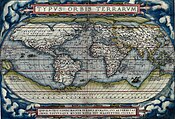
Back جغرافيا طبيعية Arabic भौतिक भूगोल AWA Fiziki coğrafiya Azerbaijani Фізічная геаграфія Byelorussian Фізычная геаграфія BE-X-OLD Физическа география Bulgarian भौतिक भूगोल Bihari প্রাকৃতিক ভূগোল Bengali/Bangla Geografia física Catalan Fyzická geografie Czech

| Part of a series on |
| Geography |
|---|
 |
Physical geography (also known as physiography) is one of the three main branches of geography.[1][2][3][4][5] Physical geography is the branch of natural science which deals with the processes and patterns in the natural environment such as the atmosphere, hydrosphere, biosphere, and geosphere. This focus is in contrast with the branch of human geography, which focuses on the built environment, and technical geography, which focuses on using, studying, and creating tools to obtain, analyze, interpret, and understand spatial information.[4][5][6] The three branches have significant overlap, however.
- ^ "1(b). Elements of Geography". www.physicalgeography.net.
- ^ Pidwirny, Michael; Jones, Scott (1999–2015). "Physical Geography".
- ^ Marsh, William M.; Kaufman, Martin M. (2013). Physical Geography: Great Systems and Global Environments. Cambridge University Press. ISBN 9780521764285.
- ^ a b Dahlman, Carl; Renwick, William (2014). Introduction to Geography: People, Places & Environment (6 ed.). Pearson. ISBN 9780137504510. Retrieved 28 August 2022.
- ^ a b Haidu, Ionel (2016). "What is Technical Geography" (PDF). Geographia Technica. 11 (1): 1–5. doi:10.21163/GT_2016.111.01. Archived (PDF) from the original on 19 January 2022. Retrieved 22 July 2022.
- ^ Dada, Anup (December 2022). "The Process of Geomorphology Related to Sub Branches of Physical Geography". Black Sea Journal of Scientific Research. 59 (3): 1–2. doi:10.36962/GBSSJAR/59.3.004 (inactive 2024-02-14).
{{cite journal}}: CS1 maint: DOI inactive as of February 2024 (link)
© MMXXIII Rich X Search. We shall prevail. All rights reserved. Rich X Search